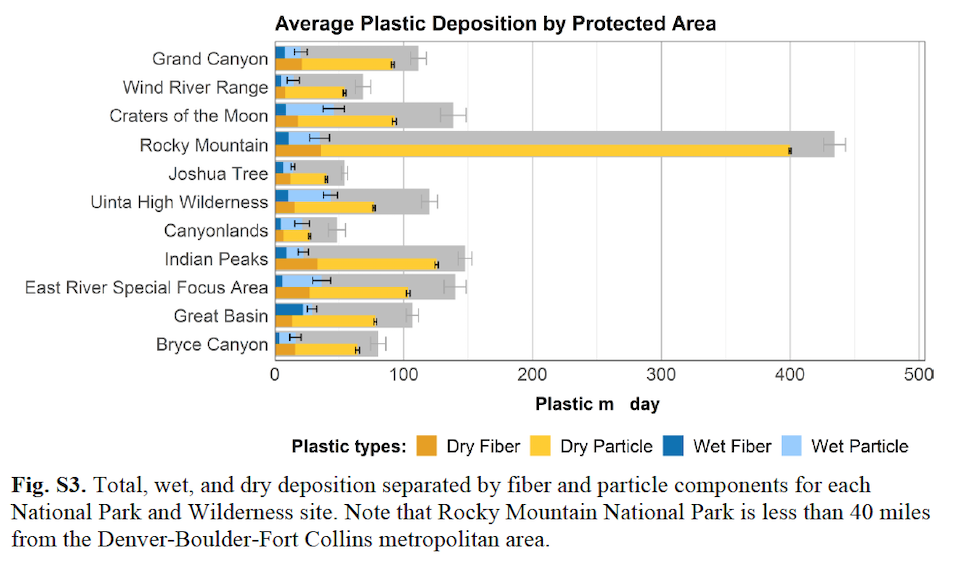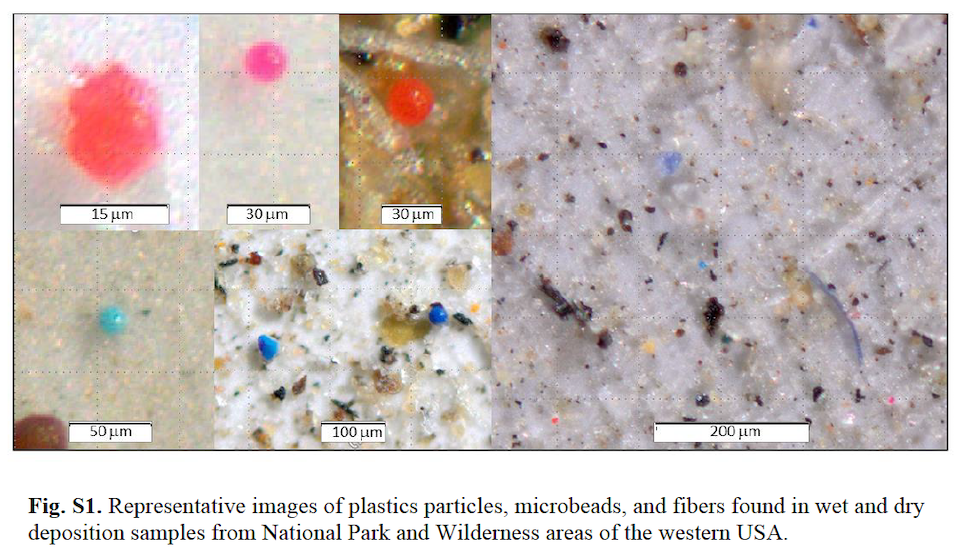
Rocky Mountain National Park lakes seem to be a catch basin for plastics pollution/Kurt Repanshek file
More than 2 million pounds of microplastics, the equivalent of 123 million plastic bottles, settle on national parks and other public lands in the West each year, adding to the growing pollution loads these protected areas carry, according to a new study.
Plastic pollution isn't new; it litters oceans, dances across landscapes in the form of plastic shopping bags caught on a breeze, and now scientists find that it is in the air people breathe in the American West.
Janice Brahney, an assistant professor at Utah State University, and her team of researchers took samples containing microplastics from Western national parks and wilderness areas. Their work underscored that plastic pollution in lakes, rivers, streams, and oceans is not the only issue to be concerned about; their findings imply that small enough plastics can be carried by the winds across the continent.
"Several studies have attempted to quantify the global plastic cycle but were unaware of the atmospheric limb," Brahney said. "Our data show the plastic cycle is reminiscent of the global water cycle, having atmospheric, oceanic, and terrestrial lifetimes."
Brahney's work, described in the June 12 issue of Science Magazine, stemmed from 14 months of work in seven national parks and four wilderness areas. During that period they trekked to places such as Bryce Canyon, Canyonlands, Grand Canyon, Great Basin, Joshua Tree, and Rocky Mountain national parks, as well as Craters of the Moon National Monument and Preserve. Their analysis concluded that more than 1,000 tons of microplastics are deposited across public lands each year.
Rocky Mountain, less than 40 miles from the Denver metropolitan area, far and away carried the highest plastics concentrations of the locations sampled.

Last fall, a U.S. Geological Survey report cited microscopic plastic particles found in high-country lakes in Rocky Mountain National Park in Colorado. While Gregory Wetherbee was studying nitrogen pollution in the park, he found that more than 90 percent of his samples contained colorful plastic particles. Some turned up in a lake above 10,300 feet in elevation.
"(F)requent observation of plastic fibers in washout samples from the remote site CO98 at Loch Vale in Rocky Mountain National Park (elevation 3,159 meters) suggests that wet deposition of plastic is ubiquitous and not just an urban condition," wrote Wetherbee.
"How these plastic materials are accumulating and being assimilated in the environment and biota is unclear. Moreover, the potential effects of these materials on biota is not understood," the scientist added, concluding that "(I)t is raining plastic. Better methods for sampling, identification, and quantification of plastic deposition along with assessment of potential ecological effects are needed."
Brahney's work noted that population centers were the initial source of the plastics, which were swept up by storms and deposited into national parks by rain and snow.
"We were shocked at the estimated deposition rates and kept trying to figure out where our calculations went wrong," Brahney said. "We then confirmed through 32 different particle scans that roughly 4 percent of the atmospheric particles analyzed from these remote locations were synthetic polymers."

The researchers, who studied more than 7,000 samples, identified microfibers consisting of fabrics used to make clothing and other outdoor gear products, indicating that visitors may have contributed to the plastics deposition in national parks. Roughly a third of the particles they analyzed were "acrylic and likely derived from industrial paints and coatings," a press release announcing the finds said.
Because of the researchers' criteria -- they counted colored plastic particles under magnification -- white particles were not included in the analysis, “...suggesting our estimates of plastic deposition rates based on counts are conservative,” said Brahney.
As Wetherbee noted, Brahney and her team also said the plastics pollution had unknown consequences for humans and wildlife, but noted that the size ranges of the particles could easily be lodged in the lungs.
"Though the literature is still sparse on the effects of microplastics on terrestrial organisms, accidental ingestion by aquatic organisms has been shown to lead to blockages in the intestinal tract causing internal injury, reduced energy, and behavior modifications," they wrote. "In some cases, ingested plastics have been shown to transfer up the food chain."
The continuing rain of plastics on national parks and wilderness areas also could adversely impact the ecosystems, the Utah State study noted.
"This ubiquity of microplastics in the atmosphere and the subsequent deposition to remote terrestrial and aquatic environments raise widespread ecological and societal concerns," Brahney said. "Identifying the key mechanisms of plastic emission to the atmosphere is a first step in developing global-scale solutions."
The report is just the latest detailing pollutant loads in Western national parks. Six years ago, a USGS-National Park Service study found high mercury levels in fish in national parks from Alaska to Colorado. In some cases, the levels exceed limits OKed for human consumption.
One fish sampled for the study, taken from Yosemite National Park in California, had mercury levels of 950 parts per billion, "at which no human consumption is advised," said the report.
All 21 parks included in the four-year survey, from Denali National Park and Preserve in Alaska to Rocky Mountain National Park in Colorado, had fish with varying levels of mercury. Concentrations ranged from 9.9 parts per billion to 1,109 parts per billion, with a mean of 77.8 parts per billion.
While only 5 percent of the nearly 1,500 fish sampled had mercury concentrations exceeding a benchmark of 200 parts per billion that elicits toxic responses in fish, 35 percent of the samples had mercury levels above 90 parts per billion, high enough to impact some birds, and mercury levels in 68 percent of the fish "were above exposure levels recommended by the Great Lakes Advisory Group for unlimited consumption by humans," the study said.
"load" - Google News
June 14, 2020 at 02:46PM
https://ift.tt/30BhhGO
Microscopic Plastics Adding To Pollution Load In Western National Parks - National Parks Traveler
"load" - Google News
https://ift.tt/2SURvcJ
https://ift.tt/3bWWEYd
Bagikan Berita Ini














0 Response to "Microscopic Plastics Adding To Pollution Load In Western National Parks - National Parks Traveler"
Post a Comment